ROI on Solar Panels for Business – Is It Worth the Investment?
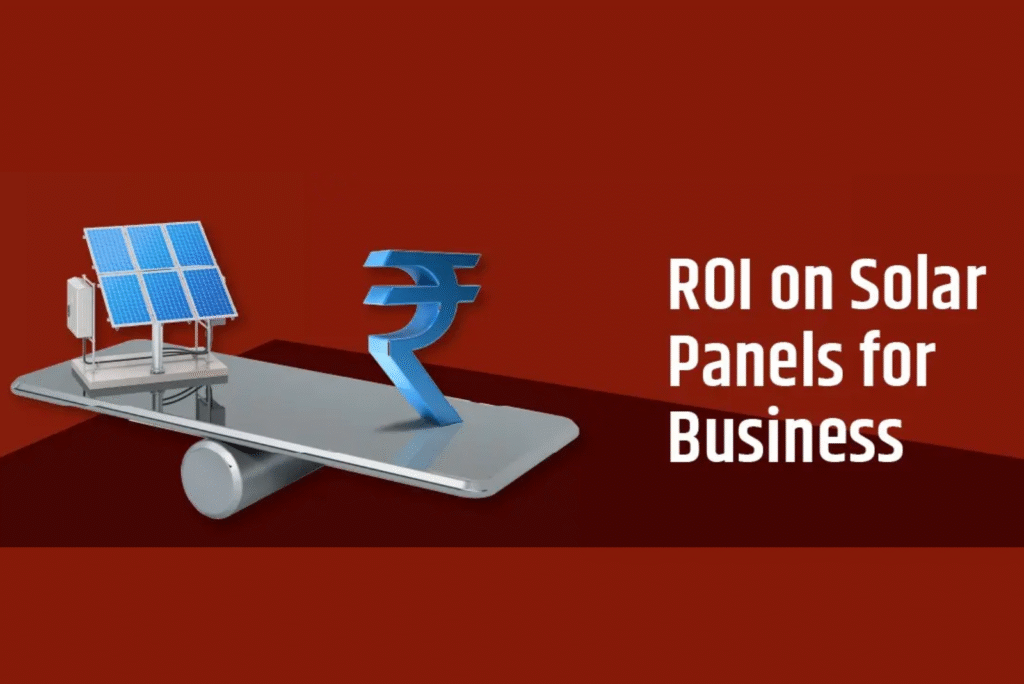
solar-roi-for-business Home Blogs Popular Posts All Posts Blog Seasonal Maintenance Tips for Solar… October 6, 2025 Solar Water Pump vs Regular… October 6, 2025 Rooftop Solar vs Ground-Mounted Solar October 6, 2025 Choosing the Best Solar Panel… October 6, 2025 Power Your Future with KLK Ventures Pvt. Ltd. Delivering reliable solar solutions for a sustainable tomorrow. Switch to clean energy and save with us today. Contact US Switching to solar isn’t just about going green anymore — it’s also about saving money. For business owners, one of the most common questions is: What’s the ROI (Return on Investment) if I install solar panels? In other words, how long will it take for the savings to match the cost? Whether you’re running a factory, office building, warehouse, or retail store, solar power can reduce your electricity bills significantly. But is it a good investment in the long run? This blog explains how ROI on solar panels works for businesses, what factors affect it, and how you can calculate the potential savings in a simple way. If you’re a farmer or know someone in agriculture, this guide will explain everything about the Government Solar Scheme for Farmers, who can apply, how it helps, and what steps to take. Also Read: Solar Water Pump What is ROI in Solar for Business? ROI (Return on Investment) means how long it takes to recover the money you spend on a project — in this case, the installation of a solar power system. When businesses install solar panels, they start saving on electricity bills immediately. Over time, these savings add up and eventually cover the total cost of installation. That’s when your ROI is achieved — and after that, the electricity is practically free. How Do Businesses Save Money with Solar? Here’s how solar helps reduce business costs: Lower electricity bills – Solar reduces dependence on grid power Fixed power cost – No fluctuation in electricity rates Tax benefits & depreciation – Businesses can claim accelerated depreciation Net metering – Excess solar energy can be sent back to the grid (if allowed) Minimum maintenance – Solar panels have a long life and low servicing needs Key Factors That Affect ROI on Solar Panels 1. Energy ConsumptionHigher electricity usage = higher savings.Businesses with 24/7 operations or heavy machinery benefit more from solar power. 2. Available Rooftop or Land AreaThe more panels you can install, the more energy you generate — which leads to more savings. A large, shadow-free rooftop gives better ROI. 3. Sunlight AvailabilityRegions with longer sunlight hours (like Rajasthan, Gujarat, Maharashtra) will generate more power per panel — speeding up your returns. 4. Type of Business OperationOffices, factories, cold storage units, data centers, and educational institutions usually have high daytime power usage — making them ideal for solar. 5. Net Metering PolicyIn states where net metering is allowed, businesses can sell extra power back to the grid, increasing returns and speeding up ROI. 6. System Quality & EfficiencyA good-quality solar system with reliable components and proper installation will work better, produce more power, and give a faster return. Average ROI Timeline – What to Expect Average ROI Timeline – What to ExpectWhile exact numbers vary, most businesses achieve full ROI in about 3 to 5 years. After that, the solar system continues to generate free power for 15 to 20+ years, depending on the panel quality and maintenance. This means businesses get 15+ years of cost-free power after the investment is recovered — which adds up to huge savings over time. Also Know: Solar Products for Home How to Estimate ROI for Your Business Here’s a simplified way to understand it: Find your average monthly electricity billEstimate how much solar can reduce that (usually 60–90%)Multiply your yearly savings by the number of years it takes to recover your investmentAfter ROI is achieved, the system keeps generating savingsExample (hypothetical): Monthly bill: ₹50,000Savings after solar: ₹35,000/monthYearly savings: ₹4.2 lakhROI achieved in: ~4 yearsFree power benefit for next 15 years = ₹60–70 lakh (approx.) Other Benefits That Support ROI Business image improvement – Seen as environmentally responsible Energy independence – Less affected by power cuts or price hikes Sustainability goals – Helps meet corporate environmental targets Increase in property value – Rooftop solar adds infrastructure value ROI is Not Just Financial – It’s Strategic For many businesses, solar isn’t just about return on money — it’s about long-term planning. Installing solar: Locks in energy costsHelps during peak demand chargesSupports operations during load sheddingFuture-proofs your energy supplyAdds to ESG (Environmental, Social & Governance) performance metrics FAQs Q1. How long does it take to break even on a solar system for business?On average, 3 to 5 years depending on usage, sunlight, and policy. Q2. Do tax benefits help improve ROI?Yes. Businesses can claim accelerated depreciation, which improves ROI. Q3. Will I still need grid electricity after installing solar?Yes, unless you install an off-grid system. Most businesses use hybrid setups. Q4. Can I add more panels later?Yes. Solar systems are modular and can be expanded based on space and need. Q5. Does regular cleaning affect performance?Yes. Clean panels produce more power and ensure faster ROI. Q6. Can solar work during cloudy days?Yes, though output may be lower. Battery backups can help smooth performance. Conclusion For businesses looking to cut down on electricity bills and become more sustainable, investing in solar panels offers excellent ROI. It’s a smart long-term decision that not only saves money but also adds value to the company. Even if the upfront investment feels big, the returns — in savings, stability, and independence — make it fully worth it. Understanding your energy needs and evaluating available rooftop space are good first steps. With proper planning and support, solar energy can help your business grow while keeping power costs under control. How to Apply for the Government Solar Scheme Visit your state’s official renewable energy website Find the PM-KUSUM or Solar Agriculture Scheme section Fill in the online application form Upload required documents Wait for verification and approval Once approved, the subsidy
Government Solar Scheme for Farmers
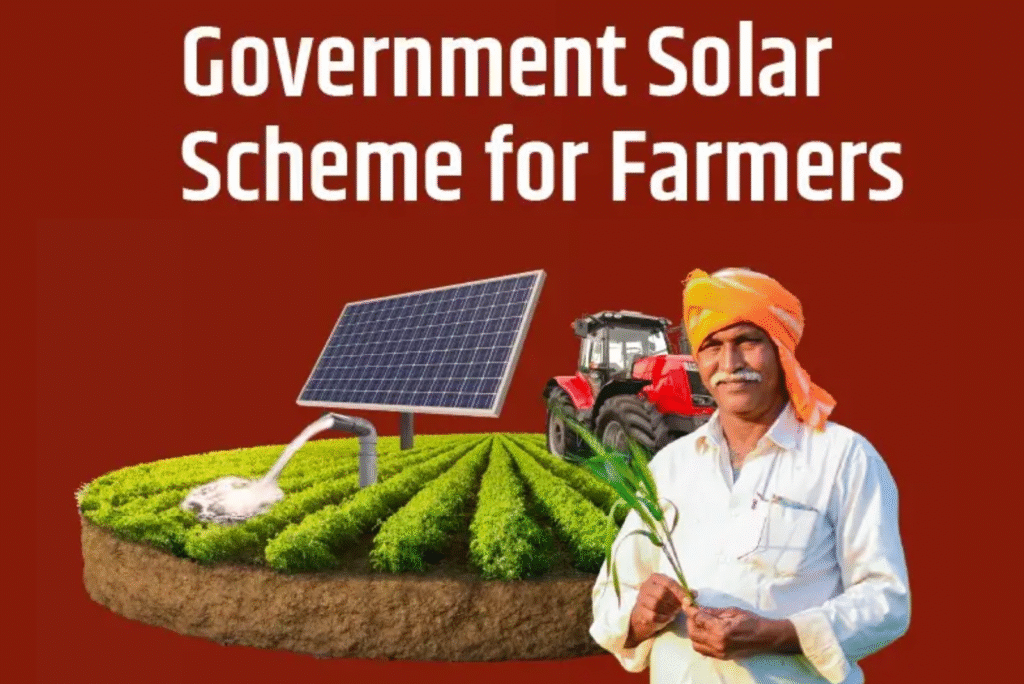
Government Solar Scheme for Farmers Home Blogs Popular Posts All Posts Blog Seasonal Maintenance Tips for Solar… October 6, 2025 Solar Water Pump vs Regular… October 6, 2025 Rooftop Solar vs Ground-Mounted Solar October 6, 2025 Choosing the Best Solar Panel… October 6, 2025 Power Your Future with KLK Ventures Pvt. Ltd. Delivering reliable solar solutions for a sustainable tomorrow. Switch to clean energy and save with us today. Contact US Running a farm is no easy job — and high fuel bills or unreliable electricity only make it harder. To help farmers reduce their costs and depend less on diesel and grid power, the Indian government has launched several solar schemes for agriculture. These programs help farmers install solar pumps and solar-powered systems with heavy subsidies. If you’re a farmer or know someone in agriculture, this guide will explain everything about the Government Solar Scheme for Farmers, who can apply, how it helps, and what steps to take. Also Read: Solar Water Pump Why the Government is Promoting Solar Energy in Farming Farming needs electricity — for irrigation, lighting, storage, and more. But in many villages, power supply is irregular or completely unavailable. Diesel is expensive, and pollution from generators is harmful. That’s why the government is pushing solar energy as a clean, low-cost, and long-term power source for farms. Solar works well during the day — exactly when most farming operations happen. Also Know: Solar Water Pumps in Agriculture Main Government Solar Scheme for Farmers – PM-KUSUM Yojana The PM-KUSUM Scheme (Pradhan Mantri Kisan Urja Suraksha evam Utthaan Mahabhiyan) is the main national solar program for farmers in India. It was launched to help farmers shift to solar energy and reduce their reliance on diesel or electricity for irrigation. PM-KUSUM has 3 key parts: Component A – Solar Power Plants on Farmland Farmers or groups can set up small solar plants (up to 2 MW)Install them on unused land or even over canalsExtra power generated can be sold to the local DISCOM (power company)Helps farmers earn additional incomeAlso Read: Solar Power Solutions Component B – Standalone Solar Pumps Solar-powered water pumps for irrigation Best for areas with no power grid or limited electricity Ideal for small and marginal farmers Works well in daylight, no battery required Component C – Solar Pumping with Grid Connection Grid-connected solar pumps that can send extra electricity back to the gridFarmers use solar energy during the day and sell surplus powerHelps reduce electricity bills and creates a second source of income Benefits of Government Solar Schemes for Farmers Benefit What It Means Reduced Fuel Cost No need for diesel or electricity from the grid Free Energy from Sun Solar power is clean and free to use Increased Income Sell extra power to DISCOMs Government Subsidy Big part of cost covered under the scheme Less Pollution No smoke or harmful emissions Works in Remote Areas Ideal for villages with poor power access Who Can Apply for the Solar Scheme? The scheme is open to: Individual farmersFarmer producer groups (FPOs)Cooperatives and panchayatsWater user associationsSmall and marginal landowners What Can You Use the Solar Setup For? Under government schemes, farmers can use solar power for: Water pumping through tubewells and borewellsDrip irrigation and sprinkler systemsStorage of perishable crops in solar-powered cold roomsSolar fencing for crop protectionSolar lights for field and farm security Documents Required to Apply To apply under the scheme, farmers usually need: Aadhaar Card Land ownership proof Bank account details (linked with Aadhaar) Passport-size photo Mobile number Copy of land revenue receipt or land map How to Apply for the Government Solar Scheme Visit your state’s official renewable energy website Find the PM-KUSUM or Solar Agriculture Scheme section Fill in the online application form Upload required documents Wait for verification and approval Once approved, the subsidy amount is adjusted directly with the system provider Installation is done by an approved vendor KLK Ventures helps farmers with the entire process — from application to installation. State-wise Support and Variations While PM-KUSUM is a national scheme, many states offer additional incentives or faster processing. For example: Rajasthan – One of the most active states under PM-KUSUM Madhya Pradesh & Uttar Pradesh – Strong solar pump adoption Maharashtra & Gujarat – Additional top-up subsidies Punjab & Haryana – Special focus on small landholders Each state has its own quota, timeline, and selection process. FAQs Q1. Can I get a solar pump through the government scheme?Yes, under PM-KUSUM, you can apply for a subsidized solar water pump. Q2. What is the subsidy percentage?Subsidy usually covers 60–90% depending on your state and the scheme component. Q3. Do I need to own land to apply?Yes, land ownership or lease documents are required. Q4. Can I earn money by selling power to the grid?Yes, under Component A and C, you can sell excess solar power and earn. Q5. Does KLK help with subsidy applications?Absolutely. KLK Ventures supports farmers with the complete process. Q6. Is the solar system safe and durable?Yes, systems come with strong build quality and long-term warranties. Q7. How long does it take from application to installation?Usually between 30–60 days, depending on the approval speed and location. Conclusion The Government Solar Scheme for Farmers is a golden opportunity to reduce farming costs, save energy, and make agriculture more sustainable. With solar power, farmers don’t just save money — they also gain freedom from unreliable electricity and fuel. With the help of trusted partners like KLK Ventures, it’s easy to shift to solar with expert support and access to government benefits. If you’re a farmer looking for better power options, solar is the way forward.
Solar Tubewell System for Farmers
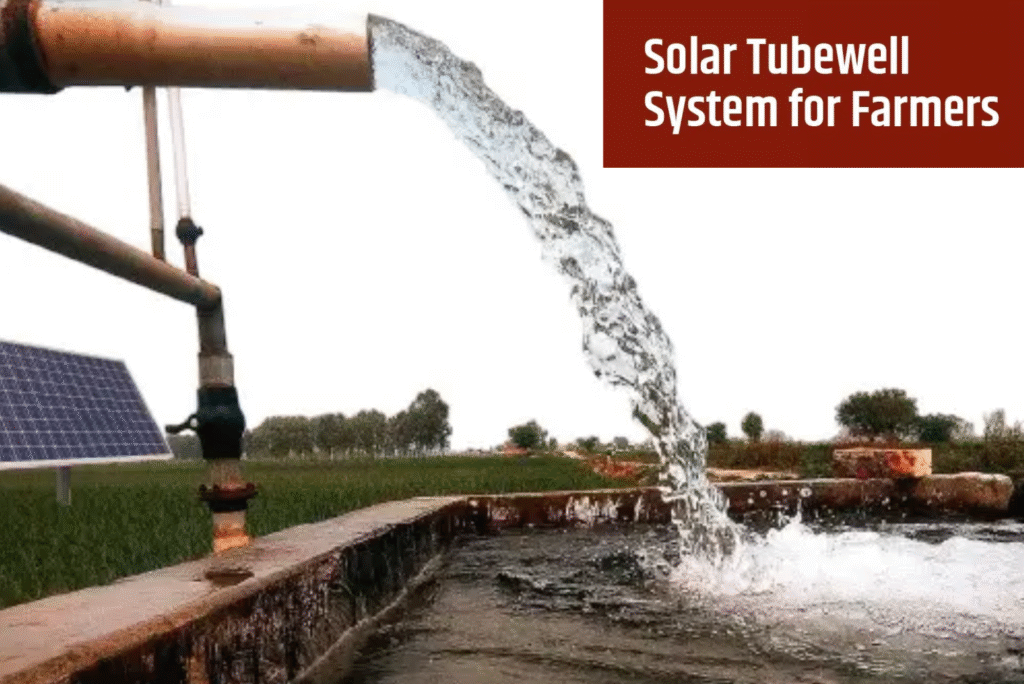
Solar Tubewell System for Farmers Home Blogs Popular Posts All Posts Blog Seasonal Maintenance Tips for Solar… October 6, 2025 Solar Water Pump vs Regular… October 6, 2025 Rooftop Solar vs Ground-Mounted Solar October 6, 2025 Choosing the Best Solar Panel… October 6, 2025 Power Your Future with KLK Ventures Pvt. Ltd. Delivering reliable solar solutions for a sustainable tomorrow. Switch to clean energy and save with us today. Contact US Power cuts, rising fuel prices, and limited electricity supply are some of the everyday challenges Indian farmers face — especially when it comes to irrigating their fields. For those using tubewells, the cost and uncertainty of running pumps can make farming harder. But now, there’s a cleaner, more reliable way to solve this problem: the solar tubewell system. In this blog, we’ll explain what a solar tubewell system is, how it works, its benefits, and why it’s becoming a trusted solution for agriculture across India. What is a Solar Tubewell System? A solar tubewell system uses sunlight to power a pump that pulls underground water through a tubewell. It includes solar panels, a pump controller (or inverter), and the pump itself. Since most farmers need water during the day, solar power matches perfectly with the irrigation schedule. With solar, there’s no need for diesel refills or waiting for grid electricity — just sunlight, which is free and available almost every day in most parts of India. Also Know: Power Backup Options How Does It Work? The system works like this: Solar panels convert sunlight into electricity This electricity powers the water pump The pump draws water from a borewell or tubewell Water is delivered to fields using pipes, drip systems, or canals It’s a straightforward system that brings a lot of value to farmers, especially in off-grid or low-power areas. Also Read: Solar Products for Home Types of Solar Pumps Used in Tubewells There are two common types of solar-powered pumps: 1. Surface Solar PumpsInstalled above the water sourceIdeal for shallow water levels like ponds or open wellsEasier to maintainSuitable for small farms and gardens 2. Submersible Solar PumpsInstalled deep inside borewells or tubewellsDesigned for pulling water from deeper underground levelsSuitable for medium to large farmsOffers steady and strong water flow Why Farmers are Switching to Solar Tubewells Solar tubewell systems solve many problems that come with fuel-based and electric pumps: No electricity or fuel cost after installation Works even in remote villages with no grid power Low maintenance with long system life Eco-friendly – no smoke, noise, or pollution Matches irrigation hours – water when the sun shines Simple and safe for daily use Where Can These Systems Be Used? Solar tubewells are perfect for: Crop irrigation (wheat, rice, sugarcane, cotton, vegetables)Fruit orchards and nurseriesFish farming pondsLivestock water needsGreenhouses and small polyhouses Support from the Government The Indian government is actively encouraging the use of solar in agriculture through various subsidy programs. PM-KUSUM YojanaOffers subsidies to farmers for setting up solar pumpsSupports both off-grid and grid-connected systemsFocused on reducing diesel usage and improving irrigationHelps small and marginal farmers benefit from solar energyState Government SchemesSeveral states offer their own solar pump programs — with simplified procedures and additional financial help. KLK Ventures assists farmers with all documentation and approvals needed to apply for these subsidies. KLK Ventures – Helping Indian Farmers Go Solar At KLK Ventures, we help farmers across India adopt solar energy in the simplest, most affordable way. Our services include: Free land and site surveys Expert guidance on pump selection Supply and installation of full solar tubewell systems Government subsidy application support On-site testing and after-sales service Important Tips Before Installing a Solar Tubewell Here are a few things to keep in mind before setting up your system: Check water depth – deeper wells need submersible pumps Ensure open space for solar panel installation Clean the panels once a month to maintain efficiency Keep documents like land records and Aadhaar ready for subsidy Use drip systems to make the most of water output FAQs Q1. Do solar tubewells need batteries?No, most systems work without batteries during sunlight hours. Q2. Will it work on cloudy days?Yes, but performance may be slightly reduced. It works best on sunny days. Q3. Is maintenance costly?No. Basic maintenance includes cleaning panels and checking wiring. Q4. Can I use solar tubewells for drip irrigation?Absolutely. They’re perfect for modern water-saving systems. Q5. Can KLK Ventures help with government subsidies?Yes, we guide farmers through the full process of subsidy approval. Q6. How long does the system last?Solar panels can last over 20 years, and pumps typically last 8–10 years. Q7. Where can KLK Ventures install these systems?We offer pan-India service and support. Contact us to check availability.
Solar Inverter vs Normal Inverter – What’s the Difference?
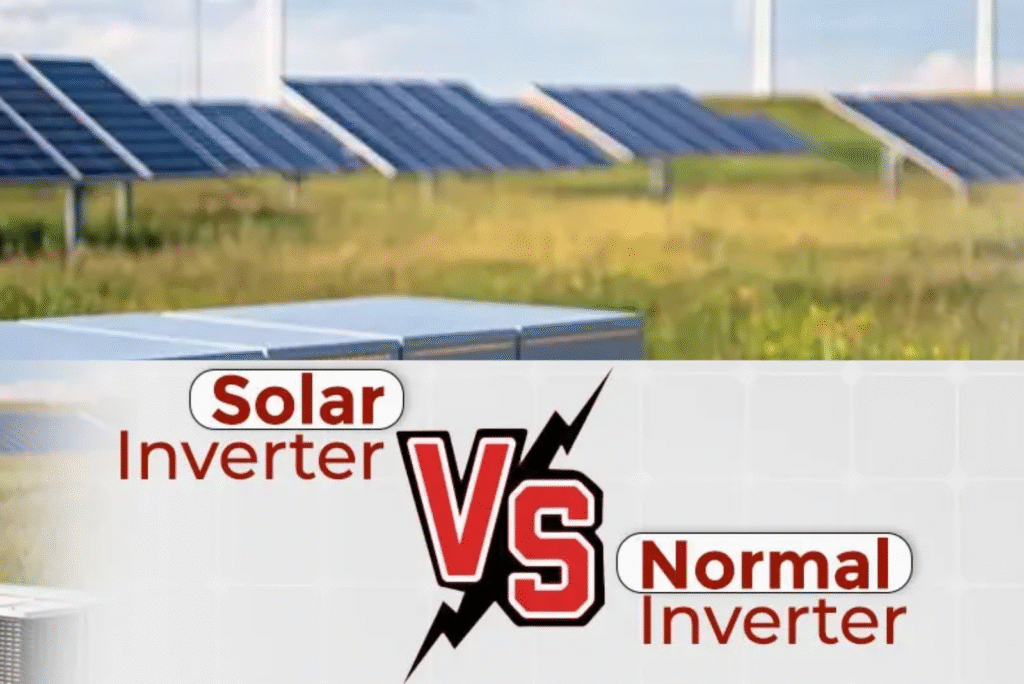
Solar Inverter vs Normal Inverter – What’s the Difference? Home Blogs Popular Posts All Posts Blog Seasonal Maintenance Tips for Solar… October 6, 2025 Solar Water Pump vs Regular… October 6, 2025 Rooftop Solar vs Ground-Mounted Solar October 6, 2025 Choosing the Best Solar Panel… October 6, 2025 Power Your Future with KLK Ventures Pvt. Ltd. Delivering reliable solar solutions for a sustainable tomorrow. Switch to clean energy and save with us today. Contact US In today’s world, where electricity is essential and power cuts are still common in many areas, inverters have become a household need. With solar energy becoming more popular, many people now wonder: should I get a solar inverter or a normal inverter? Both have their own uses, and the choice depends on what you’re looking for — just backup, or also long-term power savings. In this blog, we’ll explain the difference between a solar inverter and a normal inverter in the simplest way, so you can decide which one suits your needs better. What is a Normal Inverter? A normal inverter, also called a conventional inverter, is a power backup device. It stores electricity from the grid in a battery and uses it during power cuts. How It Works:It charges the battery when power is available.During a power cut, the inverter supplies electricity from the battery to run essential devices.It’s a common solution in homes, shops, and small offices where short-term backup is needed. What is a Solar Inverter? A solar inverter is used in systems that include solar panels. It converts the direct current (DC) produced by solar panels into alternating current (AC) used by your home appliances. How It Works:Solar panels generate electricity from sunlight.The inverter converts it to AC power.The system can either store the energy in batteries, supply it directly to your home, or send it back to the electricity grid. Types of Solar Inverters There are three main types of solar inverters, and each one works slightly differently based on how you plan to use solar power. Choosing the right one depends on whether you want to stay connected to the electricity grid, go completely off-grid, or use both. 1. On-Grid Solar InverterConnected to the main electricity supply (grid)Does not require batteriesExcess power can be sent back to the gridReduces monthly power billsWorks only when the grid is available2. Off-Grid Solar InverterWorks without a grid connectionRequires batteries to store energySuitable for areas with no electricity accessProvides full independence from power cuts3. Hybrid Solar InverterA mix of on-grid and off-gridCan store power in batteries and send excess to the gridOffers backup during power cuts and also reduces billsIdeal for people who want flexibility and long-term savings Solar Inverter vs Normal Inverter – Key Differences Feature Normal Inverter Solar Inverter Power Source Grid only Solar + Grid Energy Savings No Yes Use of Sunlight No Yes Works During Power Cuts Yes Yes (with battery) Impact on Bills No impact Can reduce bills Eco-Friendly No Yes Setup Cost Lower Slightly higher (but savings over time) When Should You Choose a Normal Inverter? A normal inverter may be the right choice if: You live in a city with occasional power cutsYou don’t have rooftop space for solar panelsYou only need backup for lights, fans, and small devicesYour budget is limited and you’re not focusing on power savings When Should You Choose a Solar Inverter? A solar inverter is a good choice if: You have rooftop space with good sunlight You want to save on electricity bills You live in an area with long or frequent power cuts You prefer clean energy and want a long-term solution You already have solar panels or plan to install them Benefits of Solar Inverters Over Normal Inverters Saves Money on Bills – Solar reduces your electricity use from the gridGreen and Clean – Solar is a renewable energy sourceLong-Term Investment – Slightly higher setup cost, but pays back over timeUseful During the Day – Can power appliances in real-time using sunlightCan Work Independently – Off-grid systems don’t rely on the power company What to Consider Before Making a Choice How much power do you use daily? Do you face long or frequent power cuts? Is your rooftop suitable for solar panels? Are you looking only for backup or also to save on power bills? Can you manage an upfront investment for long-term benefits? Answering these questions will help you decide whether a solar or normal inverter fits your lifestyle better. FAQs Q1. Can I upgrade my normal inverter to a solar inverter?Some inverters can be modified using a solar charge controller. But it’s usually better to install a proper solar inverter system. Q2. Do solar inverters work on cloudy days?Yes, but with reduced efficiency. Systems with batteries can store energy for later use. Q3. Are solar inverters more expensive?The setup cost is higher, but solar inverters save money in the long run. Q4. Can I run heavy appliances on both types?Yes, depending on the inverter’s capacity. Make sure the system is sized correctly. Q5. What maintenance do inverters need?Both types require basic checks and battery health monitoring. Solar panels should be cleaned regularly. Q6. Do I still need a battery with a solar inverter?For off-grid or hybrid systems, yes. On-grid systems can work without batteries. Conclusion Both solar inverters and normal inverters serve different needs. A normal inverter is a simple solution for short-term power backup, while a solar inverter offers backup plus long-term savings, reduced electricity bills, and an eco-friendly lifestyle. Understanding your energy usage and future plans will help you make the right choice. With the growing shift toward solar energy, many homes and businesses are now choosing solar inverters as a smarter and more sustainable option.
Solar Power Solutions for Indian Farmers
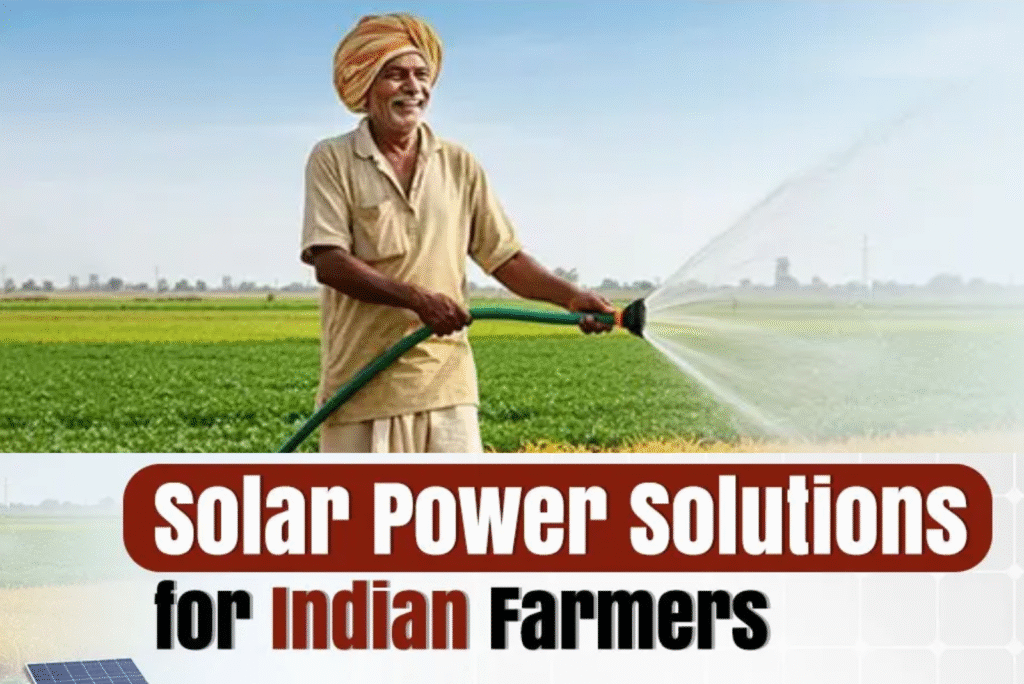
Solar Power Solutions for Indian Farmers Home Blogs Popular Posts All Posts Blog Seasonal Maintenance Tips for Solar… October 6, 2025 Solar Water Pump vs Regular… October 6, 2025 Rooftop Solar vs Ground-Mounted Solar October 6, 2025 Choosing the Best Solar Panel… October 6, 2025 Power Your Future with KLK Ventures Pvt. Ltd. Delivering reliable solar solutions for a sustainable tomorrow. Switch to clean energy and save with us today. Contact US Power cuts in rural areas, rising diesel costs, and unreliable electricity — these are common problems farmers face across India. But there’s a simple, smart, and long-term solution: solar power for agriculture. Today, more and more farmers are turning to solar energy to run water pumps, lights, cold storages, and even tractors. It saves money, reduces fuel dependency, and works well in areas with little to no power supply. In this blog, we’ll explain how solar power is changing agriculture in India, its benefits, available systems, and how farmers can adopt it easily. Also Read: Power Backup Options Why Solar Power is Perfect for Agriculture Farmers often need electricity during the day — for pumping water, powering lights, or operating machines. That’s when the sun is at its peak, making solar the most practical energy source. Here’s why it’s a great fit: Abundant sunlight across most Indian villages Free power after initial installation Low maintenance compared to diesel engines Works in remote areas where grid supply is poor Government subsidies available to reduce cost Common Uses of Solar Power in Agriculture Here are the main ways solar energy helps Indian farmers: 1. Solar Water PumpsPurpose: To draw water from wells, rivers, or borewells for irrigationTypes: Surface pumps and submersible pumpsWhy It’s Useful:Runs during the day (when needed most) Replaces expensive diesel pumps No fuel cost or pollution Capacity: Available from 1 HP to 10 HP or more 2. Solar Lighting for FarmsPurpose: To light farm areas, cowsheds, and fences at nightWhy It’s Useful:Keeps areas secure from animals or theft Saves electricity bills Solar street lights require no wiring 3. Solar-Powered Cold Storage UnitsPurpose: To store fruits, vegetables, milk, or flowers at the right temperatureWhy It’s Useful:Reduces spoilage Helps farmers sell produce later at better prices Saves on diesel cold storage costs 4. Solar DryersPurpose: To dry crops like spices, grains, and herbs using solar heatWhy It’s Useful:Faster than traditional drying methods Protects from dust, insects, and rain Maintains better quality 5. Solar FencingPurpose: To protect crops from stray animalsWhy It’s Useful:Lowers loss due to damaged crops Easy to install and cost-effective in the long term Benefits of Using Solar Power in Farming Benefit Description Cost Saving No recurring fuel cost after setup Eco-Friendly Zero emissions, supports sustainable farming Low Maintenance Once installed, requires minimal servicing Long Life Solar panels last 20–25 years Works in Off-Grid Areas Perfect for villages with poor power supply Government Support 30–90% subsidy under PM-KUSUM and other schemes Government Support & Subsidies for Farmers To promote solar energy, the Indian government offers subsidies under various schemes: PM-KUSUM Yojana – Helps farmers install solar pumps and systems Up to 60–90% subsidy depending on state Covers solar pump installation and grid-connected systems State-specific programs – Additional support in states like Maharashtra, Rajasthan, Uttar Pradesh, Tamil Nadu, etc. Farmers can apply through official state nodal agencies or renewable energy departments. Real Example – Solar Pump Helping a Village in Rajasthan A farmer in Barmer district, Rajasthan, recently switched from a diesel pump to a 5 HP solar-powered submersible pump. In just one year, he saved over ₹25,000 in fuel costs, reduced downtime, and even helped neighboring farms with shared irrigation. Many farmers in Punjab, Gujarat, Kashmir, Bihar and Maharashtra are now following the same path — proving that solar is not just a trend, it’s the future of farming. KLK Ventures – Supporting India’s Solar Agriculture Growth At KLK Ventures, we help farmers and agribusinesses install high-quality solar systems tailored to their land, water source, and budget. Our services include: Solar pump selection and installationSite inspection and feasibility reportsSolar lighting and fencing solutionsCold storage solar systemsHelp with subsidy applications and approvalsPost-installation support & maintenanceWhether you’re a small farmer or a large farm owner, our team at KLK India is here to help you shift to clean, reliable, and cost-effective solar energy. FAQs Q1. Is solar power enough to run farm equipment?Yes, with the right panel size and inverter, solar can run pumps, lights, and even cold storage units. Q2. How much subsidy can a farmer get?Under PM-KUSUM, farmers can get 60–90% subsidy depending on location and setup. Q3. What is the cost of a solar water pump?A 3HP solar pump may cost ₹1.5–2.5 lakh before subsidy. Final price depends on brand, type, and site. Q4. Can solar pumps work in cloudy weather?They work best in sunlight but still operate (at lower efficiency) during cloudy days. Q5. How long do solar panels last?Usually 20–25 years with proper care. Q6. Are solar systems difficult to maintain?Not at all. Regular panel cleaning and basic checks are enough. Q7. Can KLK Ventures install solar systems anywhere in India?Yes, we provide pan-India solar services with trained engineers and local support. Q8. Can solar power be used for drip irrigation?Yes. Solar pumps can easily be connected with drip systems to save both water and energy.
Power Backup Options for Home & Business in India
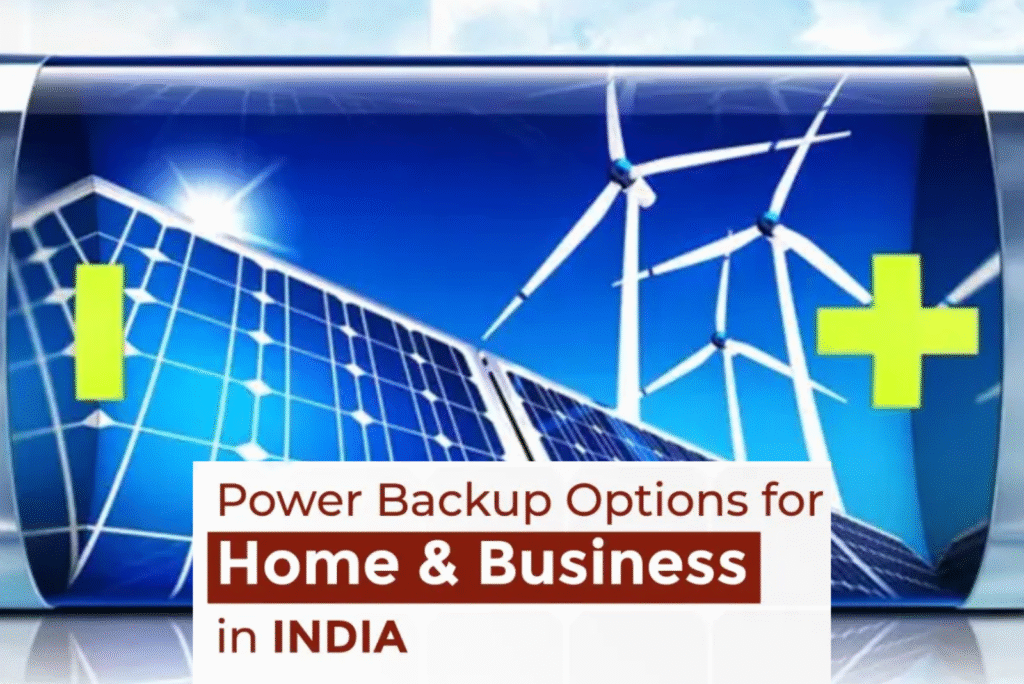
Power Backup Options for Home & Business in India Home Blogs Popular Posts All Posts Blog Seasonal Maintenance Tips for Solar… October 6, 2025 Solar Water Pump vs Regular… October 6, 2025 Rooftop Solar vs Ground-Mounted Solar October 6, 2025 Choosing the Best Solar Panel… October 6, 2025 Power Your Future with KLK Ventures Pvt. Ltd. Delivering reliable solar solutions for a sustainable tomorrow. Switch to clean energy and save with us today. Contact US We’ve all been there — power cuts in the middle of work, cooking, or relaxing. In a country like India where electricity supply can be unpredictable, having a reliable power backup option isn’t just smart — it’s necessary. Whether you live in a flat, run a shop, or manage an office, power backup systems help keep your day running smoothly. This blog will walk you through the most common and useful power backup options available today, their pros and cons, and how to choose what’s right for your home or business. Why Do You Need Power Backup at All? Before we talk about types, let’s understand why power backup is important: Uninterrupted work & productivity Comfort during summer outages Safe operation of medical or security equipment Protection for devices from sudden shutdowns Peace of mind during storms or grid failures Types of Power Backup Options Available Here are the most commonly used power backup systems in India: 1. Inverter and Battery System (for Homes & Small Offices)What It Is: An inverter stores power in a battery and supplies electricity during cuts.Best For: Homes, small shops, small officesPower Capacity: Usually supports lights, fans, TV, laptopPros:Affordable Easy to install Low maintenance Cons: Doesn’t support heavy appliances like AC, fridge, etc. Battery needs replacement every few years 2. Diesel Generators (DG Sets) – For Large LoadsWhat It Is: A generator that runs on diesel and supplies power instantly.Best For: Offices, factories, events, schoolsPower Capacity: Can support heavy machinery, lifts, ACs, and morePros: Reliable and strong output Runs for long hours Cons: Noisy and polluting Requires diesel refilling and regular servicing High initial and operational cost 3. Solar Power Backup (With Battery Storage)What It Is: Solar panels generate electricity which gets stored in a battery for later useBest For: Eco-conscious homes, remote areas, long-term savingsPower Capacity: Depends on panel size; scalablePros:Green and sustainable Low electricity bills Government subsidies available Cons: High initial setup cost Depends on sunlight availability 4. UPS (Uninterruptible Power Supply) – For Computers and Critical DevicesWhat It Is: A small power backup device for computers and electronicsBest For: IT rooms, server rooms, personal PCsPower Capacity: Short-term backup (10-20 mins)Pros:Instant switch to battery Prevents data loss Cons: Not meant for running devices long-term Limited power capacity 5. Hybrid Systems (Inverter + Solar + Grid)What It Is: A smart system that combines grid power, solar energy, and battery storageBest For: Homes and businesses seeking flexibilityPros:Smart usage of multiple power sources Great for areas with irregular supply Cons: Requires professional setup Slightly expensive but cost-effective in the long run How to Choose the Right Power Backup Option? Every home or business has different needs. Here’s what to consider: Power load: List how many devices you want to run during a cut Budget: Don’t overspend — start with what you really need Duration of backup: Short-term or long hours? Space available: DG sets need open space for exhaust Environment impact: Prefer solar if you want eco-friendly backup Future usage: Go for scalable systems if usage may increase Real-Life Example – What Businesses Are Doing Today Many businesses are switching to solar + inverter hybrids for cost savings and sustainability. For example, a school in Noida recently installed a solar-powered inverter system that powers 80% of their daytime load and runs backups during cuts — saving both electricity and diesel bills. Similarly, small offices are now replacing noisy generators with lithium battery-powered inverters, which are compact and silent. KLK Ventures’ Role in Power Backup Solutions At KLK Ventures Private Limited, we understand how critical power is for homes, industries, and institutions. Our DG sets, hybrid energy systems, and consulting services help you choose the most efficient solution as per your budget and requirement. Whether you’re setting up power backup for a housing society, factory, school, or corporate office, our team offers: DG Set supply & installation AMC & Maintenance services Solar backup systems with inverter support Technical support and load analysis Explore our services on www.klkindia.com or contact us for a customized consultation. FAQs Q1. What’s the best power backup option for homes?A: Inverter and battery systems are the most affordable and easy for home use. Q2. Can solar systems work as full power backup?A: Yes, if combined with battery storage, solar can fully support homes and small businesses. Q3. Are DG sets still useful?A: Yes, for heavy usage like factories or buildings, DG sets provide strong, long-term power. Q4. Which option is most eco-friendly?A: Solar power is the cleanest and most sustainable backup. Q5. What is the lifespan of an inverter battery?A: Usually 3–5 years, depending on usage and maintenance. Q6. How do I calculate my power backup requirement?A: List all appliances you need during a cut and check their wattage total. Q7. Do power backups require government approval?A: Only for commercial DG sets or solar installations above a certain size. Q8. Can I combine multiple power sources?A: Yes, hybrid systems offer great flexibility by combining grid, solar, and battery. Conclusion Renewable energy is not just a trend — it’s the smart way forward. Whether it’s a solar panel on your roof, a windmill on a hill, or a hydro dam in a river — these clean power sources are helping build a better, greener future. They may not be perfect yet, but they’re improving fast. With time, effort, and support, renewable energy can be the main way we power our homes, schools, and cities. And the best part? It’s something that helps everyone — people, animals, and the planet.
what-is-renewable-energy
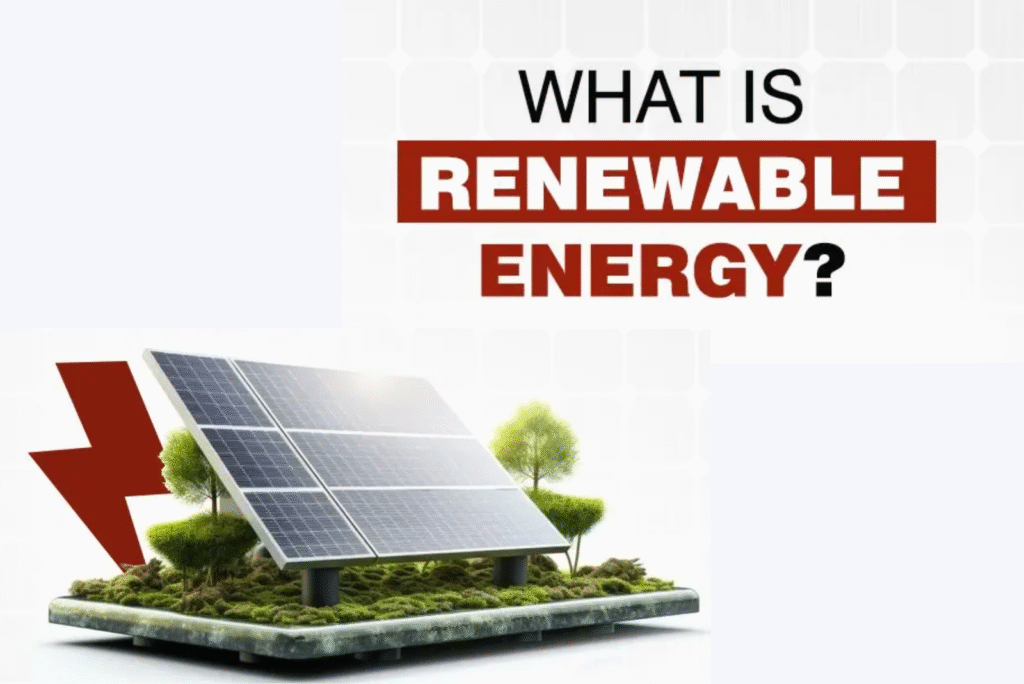
What Is Renewable Energy? Home Blogs Popular Posts All Posts Blog Seasonal Maintenance Tips for Solar… October 6, 2025 Solar Water Pump vs Regular… October 6, 2025 Rooftop Solar vs Ground-Mounted Solar October 6, 2025 Choosing the Best Solar Panel… October 6, 2025 Power Your Future with KLK Ventures Pvt. Ltd. Delivering reliable solar solutions for a sustainable tomorrow. Switch to clean energy and save with us today. Contact US Every time we switch on a fan, charge our phone, or heat water, we’re using electricity. But where does this energy come from? In many places, it still comes from burning coal or oil — things that can harm our environment. Thankfully, there’s another way: renewable energy. Renewable energy comes from natural sources that don’t run out — like the sun, wind, and water. In this blog, we’ll explain what renewable energy is in a simple way, why it matters, and how it’s changing the way the world makes power. What Does “Renewable” Actually Mean? “Renewable” means it keeps coming back. When we say renewable energy, we mean energy from sources that naturally renew themselves. The sun rises every day, rivers keep flowing, and the wind keeps blowing. These sources don’t get used up, even if we use their energy every day. Compare that to fossil fuels like coal, gas, and oil — which take millions of years to form and will run out one day. They also create pollution. Renewable sources are the opposite — they’re clean and unlimited. Types of Renewable Energy Here are some of the most common types of renewable energy used around the world: 1. Solar PowerSolar panels catch sunlight and turn it into electricity.Commonly used on rooftops of homes, offices, and schools.Also used to heat water or run streetlights.2. Wind EnergyWind turns large blades on windmills or turbines.These spinning blades generate power.Found in open fields, hills, and coastal areas where wind is strong.3. Hydropower (Water Energy)Uses flowing rivers or water stored in dams.The movement of water turns turbines to create electricity.Used a lot in hilly regions with strong river flow.4. Biomass EnergyComes from natural waste like wood, crop leftovers, or animal waste.Burned or converted into gas for power.Used in rural areas and even some factories.5. Geothermal EnergyUses heat from deep inside the Earth.Used for heating buildings or making electricity.Works best in volcanic or rocky region Why Renewable Energy Matters So Much Here’s why we should care about renewable energy: Cleaner air and water – It doesn’t release harmful smoke or chemicals. Doesn’t run out – We won’t wake up one day with no sun or wind. Protects nature – Less damage to land and wildlife. Fights global warming – Reduces carbon dioxide that causes climate change. New job opportunities – From solar panel makers to wind farm technicians. The switch to clean energy is good for our health, economy, and environment. How We Use Renewable Energy Every Day Renewable energy isn’t just for scientists or big projects. It’s being used in more everyday ways than we think: Solar panels on homes – People use them to power fans, lights, or charge batteries. Solar water heaters – Used for bathing, especially in colder regions. Electric buses and cars – In many cities, public transport runs on solar or wind-generated power. Street lighting – Many villages and towns use solar-powered lamps. Rural pumps – Farmers use solar pumps for water irrigation. What’s Holding Us Back? Despite its benefits, renewable energy has some challenges too: Weather dependent – Solar doesn’t work well on cloudy days, and wind farms need good wind. Costly to install – Panels, batteries, and turbines cost a lot at first. Takes space – Wind and solar farms need large areas of land. Storage issues – Storing power for night-time or low-sun days is still expensive. The Future Is Looking Bright India and many other countries are already taking big steps toward renewable energy: Large solar parks are being built in Rajasthan, Gujarat, and Ladakh.Wind energy is growing in Tamil Nadu and Maharashtra.Rooftop solar systems are becoming popular in homes, offices, and schools.Even small villages are being powered by solar mini-grids. FAQs Q: Is solar the best form of renewable energy?A: Not always. It depends on your location and needs. Wind, hydro, and biomass are great too. Q: Can a home run 100% on solar power?A: Yes, if it gets good sunlight and has enough panels and batteries. Q: Is renewable energy expensive?A: The initial cost is high, but over time it becomes cheaper than traditional electricity. Q: Does renewable energy work in villages?A: Yes! In fact, it’s perfect for villages that don’t have stable electricity. Q: Are batteries required for all renewable setups?A: Not always. But for using power at night or on cloudy days, storage helps. Conclusion Renewable energy is not just a trend — it’s the smart way forward. Whether it’s a solar panel on your roof, a windmill on a hill, or a hydro dam in a river — these clean power sources are helping build a better, greener future. They may not be perfect yet, but they’re improving fast. With time, effort, and support, renewable energy can be the main way we power our homes, schools, and cities. And the best part? It’s something that helps everyone — people, animals, and the planet.
Solar System Guide: Planets in Order and Fun Space Facts
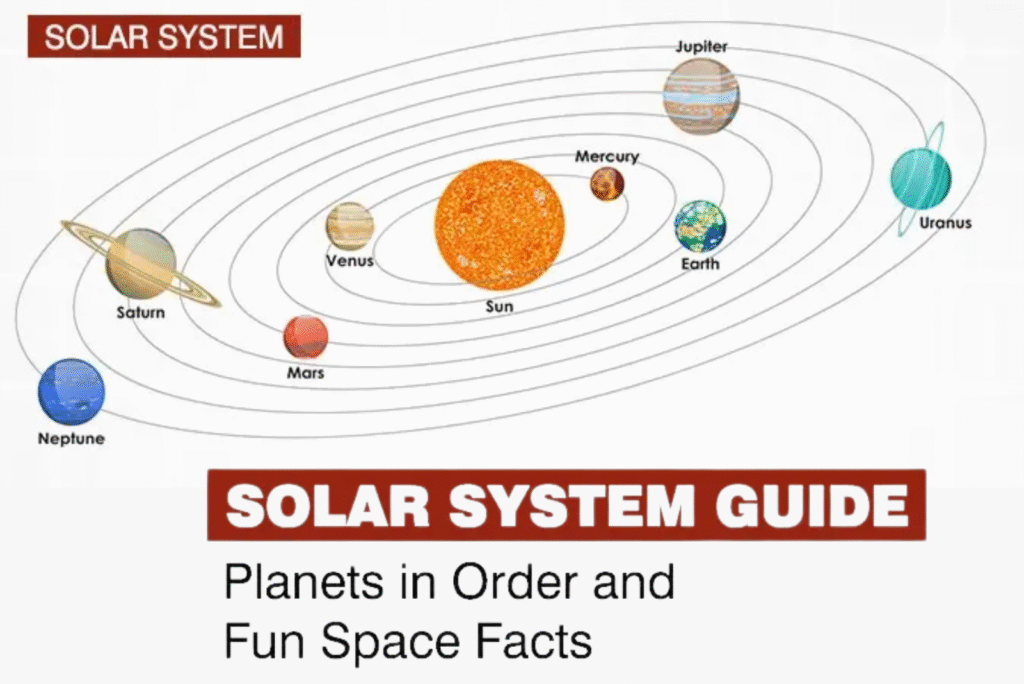
Solar System Guide: Planets in Order and Fun Space Facts Home Blogs Popular Posts All Posts Blog Seasonal Maintenance Tips for Solar… October 6, 2025 Solar Water Pump vs Regular… October 6, 2025 Rooftop Solar vs Ground-Mounted Solar October 6, 2025 Choosing the Best Solar Panel… October 6, 2025 Power Your Future with KLK Ventures Pvt. Ltd. Delivering reliable solar solutions for a sustainable tomorrow. Switch to clean energy and save with us today. Contact US The solar system is a concept people encounter in school, but most people don’t explore beyond its names and charts. This blog aims to simplify it using real concepts instead of complex science, including easy explanations and fun details to share. Every component from Mercury to Neptune (even Pluto) has unique stories which we aim to discover in this guide. Planets, moons, and asteroids will all be explored in a soothing, friendly manner that makes space feel easy. Have You Ever Wondered About The Order Of The Planets? Have you ever found yourself forgetting the order? There is a really easy trick that goes like this, My Very Educated Mother Just Served Us Noodles. This is what it translates to: 1. Mercury Closest to the Sun. Day time temperatures are always scorching while freezing temperatures take over at night. Small and rocky in composition. 2. VenusSimilar to Earth in size, but engulfed by thick poisonous clouds. It is the hottest planet. 3. EarthThe only home we have. Filled with life, water, and perfect distance from the sun. 4. MarsLooks reddish, and is cold and dry. It also has the largest canyon and the tallest volcano. 5. Jupiter The biggest planet. It has a famous red storm and many moons. It is also a gas giant. 6. SaturnHas stunning rings, which are primarily composed of ice. 7. UranusRotates on its side. The color is pale blue due to Methane gas. 8. NeptuneThe farthest from the Sun, also a deep blue. Cold and windy. Where Did Pluto Go? In 2006, it was reclassified as a dwarf planet, which striked away it’s title as the ninth planet. That’s because it didn’t clear it’s orbit of space rocks. Everyone still finds Pluto intriguing due to its five moons, one of them being Charon which is almost the same size as Pluto! Even without being classified as a full planet, it is still cherished by space enthusiasts and studied by astronomers. Other Stuff in Space (Besides Planets) The rest of the solar system holds more than just planets. Other important portions includes: Asteroids – Large rocks that mostly drift between Mars and Jupiter.Comets – As ice and dust are drawn closer to the sun, they glow and release long tails. Meteoroids – Space rocks that are small in size. When they burn up in the Earth’s atmosphere, they are called meteors. If parts of them hit the ground, those fragments are called meteorites. The Sun – It is not a planet, because it is the center of everything. It holds the cosmos with its gravity, and gives light and warmth. In the solar system everything is in constant motion, planets revolve around the sun, moons orbit planets, and even asteroids and comets are in pathways etched out by gravity. Some Planets Have Moons (Many of Them!) Let’s start with moons, Earth has one, but other planets have many: Earth – One moon, but it plays an crucial function as it helps control tides and illuminates the night sky. Mars – Small and tiny moons Phobos and Deimos that are in the shape of a peanut. Jupite – Over 90 moons, it also has the biggest moon in the solar system Ganymede. Saturn – Also is in possession of 80 plus moons which also holds Titan. Titan has thick clouds and lakes consisting of methane. Uranus and Neptune – Each have more than a dozen moons, icy and small in size. Planet Rings? More Than Just Saturn! “Ringing” is often associated with Saturn, but he certainly isn’t the only one wearing a ring. All four gas giants: Jupiter, Saturn, Uranus and Neptune, possess rings. Gas gulfs have varying ring qualities, with Jupiter having faint rings while Saturn’s are bold and wide, and Uranus and Neptune have thin, dark rings. Rings are composed of particles such as ice, rocks, and dust. It is hypothesized by scientists that they could be fragments of broken moons or comets. Did You Know? (Cool Space Facts) Here are some space facts that are sure to pique your interest: It takes approximately 165 Earth years for one single year on Neptune. Venus rotates in the opposite direction to most other planets. Mars experiences seasons similar to Earth, but they last for an extended period of time. Unlike the rest of the planets, Uranus is the coldest planet even though Neptune is farther away. The Sun will continue shining for 5 more billion years, making it around 4.6 billion years old. You would only weigh 19 kg if you were 50 kg on Earth. Jupiter has wantonly been enduring centuries of storms, with The Great Red Spot measuring far greater than Earth. Why Learn About This Stuff? Learning about space is not only for scientists, Space assists in understanding Earth better. Studying other planets gives us great insight into how weather functions, climate changes, and what may happen to our world. Moreover, wondering what is “out there” provides an extra dose of fun. While looking at the stars or waving the Moon hello, waiting for an upcoming space expedition, knowing more about the solar system enhances the thrill. Even something like solar energy, which is utilized on Earth, stems from understanding the Sun and a lot of modern-day technology was tested in space prior. And for many children and students, the basics of science-imaginary revolve on learning about planets. It nurtures curiosity and imagination, fostering creativity. FAQs Q: Is Mercury the hottest planet?A: No Venus is hotter, Mercury is closer to the Sun but lacks atmosphere to store heat. Q: How many planets are
Solar and Photovoltaic Panel Cleaning
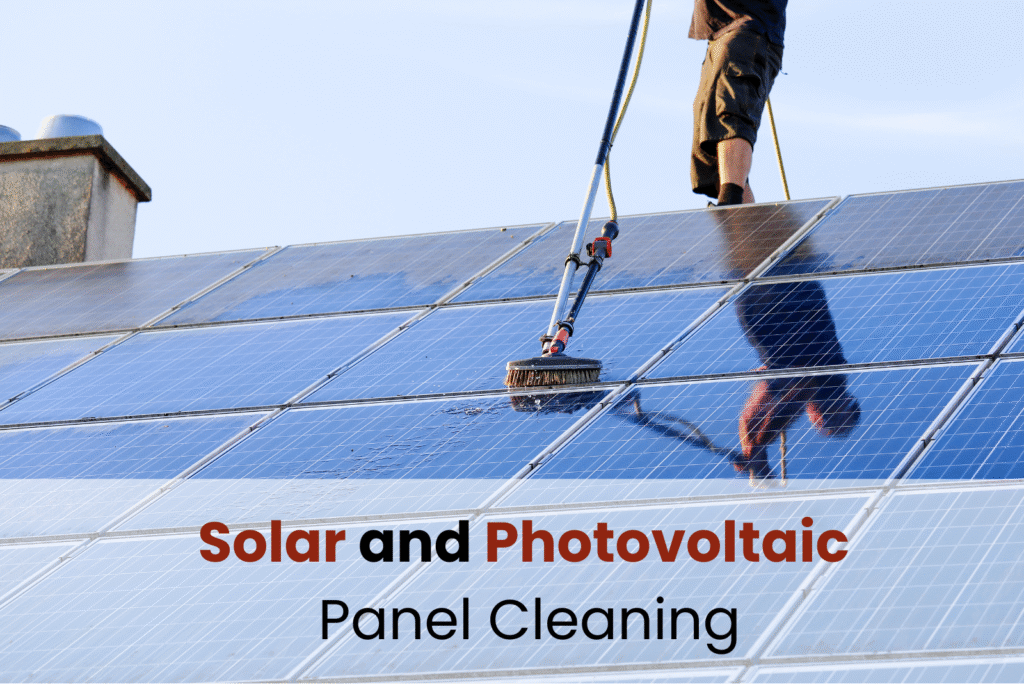
Solar and Photovoltaic Panel Cleaning Home Blogs Popular Posts All Posts Blog Seasonal Maintenance Tips for Solar… October 6, 2025 Solar Water Pump vs Regular… October 6, 2025 Rooftop Solar vs Ground-Mounted Solar October 6, 2025 Choosing the Best Solar Panel… October 6, 2025 Power Your Future with KLK Ventures Pvt. Ltd. Delivering reliable solar solutions for a sustainable tomorrow. Switch to clean energy and save with us today. Contact US Solar energy is one of the best ways to produce clean and green electricity. But just like any outdoor surface, solar panels also collect dust, dirt, bird droppings, and pollution. And when that happens, they can’t absorb sunlight properly — which means they generate less power. This blog is about how cleaning your solar and photovoltaic (PV) panels the right way can help keep them efficient and long-lasting. We’ll keep it super simple and useful, like a guide written by someone who’s been there, done that. Why Clean Solar Panels at All? Think of solar panels like windows — the cleaner they are, the more sunlight they let in. When dust and grime cover the surface, it blocks light and reduces energy output. Here’s what dirty panels can lead to: Lower power generation (sometimes by up to 20–30%)Shorter panel lifeDamage to the surface over timeIncreased energy bills for large-scale users Common Reasons Panels Get Dirty Dust and soil (especially in dry regions)Bird droppingsPollen and leavesIndustrial pollutionHard water stains after rainEven if your panels look fine from a distance, a layer of film or dirt can still block efficiency. This film often builds up slowly, making it hard to notice the drop in output right away. Best Time to Clean Your Solar Panels When it comes to cleaning, timing matters: Early morning or late evening – The panels are cool, and there’s no harsh sunlight. Cloudy days – Easier to clean without water drying too quickly. After heavy dust storms or long dry weather – Great time to remove built-up grime. How Often Should You Clean Them? Cleaning schedules depend on your environment: Residential rooftop systems: Once every 3–4 monthsCommercial and industrial systems: Every 1–2 monthsDusty or polluted areas: Possibly every monthFarm areas, desert regions, and buildings near roads or factories may need more frequent checks. Some solar farms also use automated cleaning systems with water-saving tech to clean panels without manual effort. Also Read: Which Solar Panel is Best For Homes How to Clean Solar Panels Safely Cleaning your panels is not hard, but it must be done carefully: Use soft water – Hard water can leave stains. Soft brushes or sponge only – Avoid anything sharp or abrasive. Mild soap if needed – Stay away from harsh chemicals. Turn off the system before cleaning – Safety is key. Use proper safety gear – Especially if climbing or reaching high places. Also, never clean hot panels — sudden cooling from water can crack the glass. If your panels are on the roof and not easily reachable, it’s smarter to hire a cleaning service. What to Avoid While Cleaning Pressure washers – Too strong and can damage the panels. Metal tools – Can scratch the surface permanently. Window cleaners or alcohol-based sprays – Might damage the anti-reflective coating. Signs Your Solar Panels Need Cleaning Sudden drop in energy output Visible dirt or stains Leaves or bird droppings covering part of the panel Inverter warning signs (in some systems) A quick check once a month helps catch issues early. Also Read: Which is the Best Solar Panel in India KLK Ventures’ Role in Solar Panel Efficiency KLK Ventures is committed to supporting clean energy adoption across India. One of the ways we do that is through expert cleaning and maintenance of solar and PV systems. Our trained teams handle: Regular industrial solar panel cleaning On-site safety checks Water-conserving cleaning solutions Inspection and reporting for better performance We work with rooftop setups, factories, and solar farms to make sure that their systems stay in top condition year-round. FAQs Q: Can I use pressure water to clean my panels? A: Not recommended — it can crack the glass or loosen wiring. Q: Does rain clean the panels enough?A: Sometimes, but not always. Rain can leave spots, and it doesn’t remove heavy dirt. Q: How do I know if my panels are dirty?A: You might notice lower electricity output. A quick visual check can help too. Q: Can dirty panels damage the system?A: Yes, in the long run. Dirt can create hot spots that reduce panel life. Q: Should I hire a cleaning service?A: Yes, especially for bigger installations. It’s safer and more effective. Q: How much energy can I lose if I don’t clean my panels?A: Depending on the dust level, it could be 5–30% of output loss. Q: What’s the best time of year for a deep clean?A: After the dry season or before the peak summer months is ideal. Conclusion Cleaning your solar panels isn’t just a task — it’s an essential part of solar maintenance. Dirt and dust may seem small, but they make a big difference in how much power your system can produce. By following simple cleaning practices and regular checks, you can make sure your panels last longer and save more money. KLK Ventures supports clean energy across India by making sure solar systems stay clean, efficient, and fully functional. If you own or manage a solar system, regular cleaning is not just helpful — it’s necessary. Clean panels = clean power.
How to Switch Your Home to Green Energy
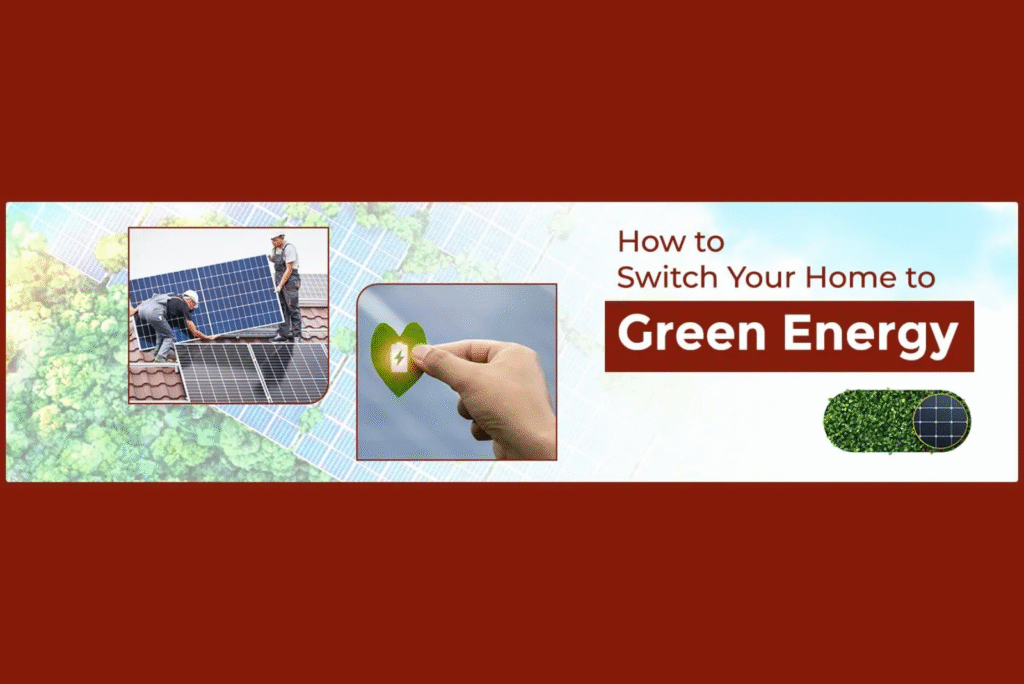
How to Switch Your Home to Green Energy Home Blogs Popular Posts All Posts Blog Seasonal Maintenance Tips for Solar… October 6, 2025 Solar Water Pump vs Regular… October 6, 2025 Rooftop Solar vs Ground-Mounted Solar October 6, 2025 Choosing the Best Solar Panel… October 6, 2025 Power Your Future with KLK Ventures Pvt. Ltd. Delivering reliable solar solutions for a sustainable tomorrow. Switch to clean energy and save with us today. Contact US With the world moving forward, many homeowners are considering green energy for their homes. It’s a safer option, and it is cost-effective in the long run. It’ll be beneficial for people who are looking to reduce their carbon footprints and cut down on electricity bills. In this blog, let’s see what green energy for home truly means, how to make the switch, and why it’s one of the most rewarding decisions you can make for your household. What Is Green Energy for Homes? It’s all about using green energy to power your homes. The green energy sources are clean and because of that, there is no air pollution like there is with the use of fossil fuels. The best part, however, is that these energy sources won’t even run out. Instead of powering homes with natural gas and fossil fuels, individuals often turn to the sun as a clean energy option. Aside from the sun, wind is also a popular source of clean electricity. Green energy is a way to sustainable living without putting the environment at risk. Easy and Effective Ways to Switch to Renewable Energy at Home Switching to green energy doesn’t have to be complex when it’s just easy. You can try these effective ways to bring green energy into your homes. 1. Install Solar PanelsInstalling solar panels is one of the fantastic ways to switch to green energy for home. There are many benefits of a solar rooftop system. You can generate clean electricity using solar panels while saving on electricity bills. A safe and easy way to make your house a home for green energy! 2. Try a Solar Water HeaterAnother option for shifting to renewable energy is to use solar water heaters. You can use this clean energy source to heat the water and maintain low electricity bills. 3. Use of Small Wind TurbinesNow, the thing is, wind turbines are mostly found on large areas of land where the air flows continuously. However, this becomes a great option if your house is in an area which is large and windy throughout; you can install a small wind turbine to generate electricity. 4. Upgrade to Energy-Efficient Appliances Traditional appliances use a lot of electricity which also raises the bills. To save yourself from this, choose appliances with green, energy-saving labels. This means that your household appliances will not use much power and save money. 5. Try Solar Air ConditioningSolar air conditioners are amazing and you’ll get to know that once you install them. These conditioners work on solar energy, which may seem strange to people, but these appliances are beneficial! Your electricity bills will go down as the heat goes up during harsh summers. 6. Choose Green Energy PlansMany electricity providers now offer green energy subscriptions. A simple call to your local utility company can shift your home to cleaner energy, without changing any hardware. Also Read – Wind Vs. Solar Energy How Much Does It Cost to Go Green at Home? This is the one thing that people often think about when planning to switch to green energy for home. The question, “How much is this going to cost me?” is always lingering around when there’s a discussion on green energy. How far you want to go with green energy, your budget, and the decisions you make will all affect the answer to this question. The best thing however, is the Government incentives that lift off the burden of high costs. Also, let’s tell you, after the initial investment, you’ll be blessed with low-maintenance systems! If you want to start small by switching to LED bulbs, outdoor solar lighting, or just buying energy-efficient appliances, you can do so with just a few thousand rupees. Some may seem a bit pricier than usual but trust us, your wallet will thank you later! Next, installing solar water heaters or solar air conditioners has slightly higher upfront costs. However, like it’s the case with any other green ways, you’re going to save a lot on electricity bills. So is the case with off-grid solar power systems for homes and solar in-roof systems. Best Solar Solutions for Residential Use Homes aren’t all the same, and neither are their energy needs. The right solar solution depends on what works best for your space and lifestyle. Rooftop Solar Panels This is a classic and effective choice. Photovoltaic panels convert sunlight into electricity very efficiently. The off-grid solar systems are great for homes located in off-grid areas with poor connectivity. They can power your home appliances, lights, fans and can even charge vehicles. Hybrid Solar Systems Now, if you think a solar system can either function alone or is connected to the grid, well you’re in for a surprise. A hybrid solar system has both features, you can use the solar power during the day and store extra energy away in a battery and you can also draw from the grid whenever you need it! Solar Water Heating Systems A quick and easy way to save money on water heating. These systems heat water using roof-mounted collectors and store it for domestic use in insulated tanks. Solar Battery Storage Many people have existing solar systems in their houses but don’t have batteries. A good solar energy storage system is needed when the sun goes down and electricity demands get high. It stores the extra energy for use later on. Combining several of these solar solutions will give your home a green and clean touch. Using green energy means making everything around you comfortable, safe, and sustainable! Government Subsidies for Green
